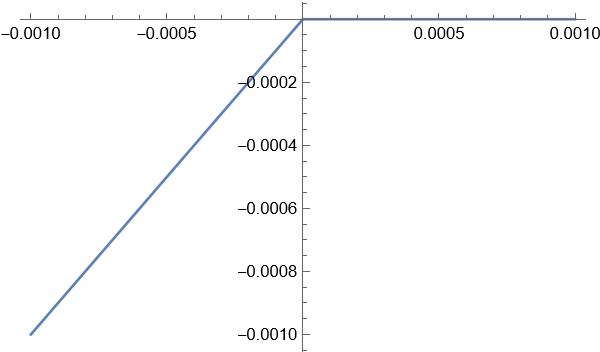1. Derive the relationship between the backward difference operator,
~∆
f ≡
f(
x) −
f(
x −
h), and the
differential operator,
D f ≡
f′(
x), and numerically obtain
f′(1.0) from the table below using all the
available information:
| x | f(x) |
| 0.20 | 1.22140276 |
| 0.25 | 1.28402542 |
| 0.30 | 1.34985881 |
| 0.35 | 1.41906755 |
| 0.40 | 1.49182470 |
| 0.45 | 1.56831219 |
| 0.50 | 1.64872127 |
| 0.55 | 1.73325302 |
| 0.60 | 1.82211880 |
| 0.65 | 1.91554083 |
| 0.70 | 2.01375271 |
| 0.75 | 2.11700002 |
| 0.80 | 2.22554093 |
| 0.85 | 2.33964685 |
| 0.90 | 2.45960311 |
| 0.95 | 2.58570966 |
| 1.00 | 2.71828183 |
2.
(a) Is f(x) continuous at x=0 ? State your rationale.
(b) Is f(x) differentiable at x=0 ? State your rationale.
1.
| |
|
| |
| |
|
|
f(x) − | ⎛
⎝
|
f(x) − h f′(x) + |
h2
2
|
f"(x) − … | ⎞
⎠
|
|
| |
| |
|
| |
|
Therefore,
or
| |
|
| |
| |
|
|
1
h
|
| ⎛
⎜
⎝
|
~
∆
|
+ |
2
|
+ |
3
|
+ |
4
|
+ … | ⎞
⎟
⎠
|
. |
| |
|

The values of
f(
x) is based on
f(
x) =
ex. Therefore,
f′(1)=
f(1)=2.71828.
Your answer must match this value.
2.
(a)
so
hence,
f(
x) is continuous at
x = 0. Note that
|
|
lim
x→ +0
|
e1/x = ∞, |
lim
x→ −0
|
e1/x = 0. |
|
(b)
|
f′(0) = |
lim
h → 0
|
|
f(0 + h) − f(0)
h
|
= |
lim
h → 0
|
|
1
1 + e1/h
|
|
|
but
|
|
lim
h → +0
|
|
1
1 + e1/h
|
= 0, |
lim
h → −0
|
|
1
1 + e1/h
|
= 1, |
|
so
f(
x) is NOT differentiable at
x = 0.
Here is a graph of
f(
x) around
x=0. It is seen that
f(
x) is continuous (no hole) but not differentiable (not smooth) at
x=0.

 The values of f(x) is based on f(x) = ex. Therefore, f′(1)=f(1)=2.71828.
Your answer must match this value.
The values of f(x) is based on f(x) = ex. Therefore, f′(1)=f(1)=2.71828.
Your answer must match this value.


